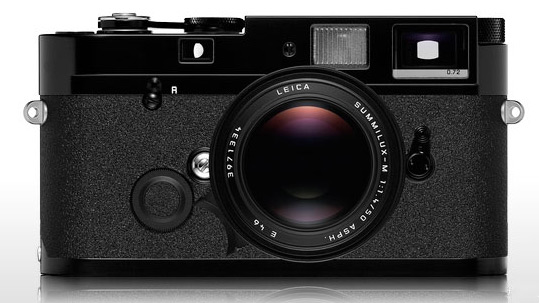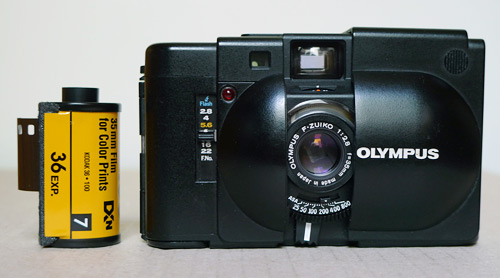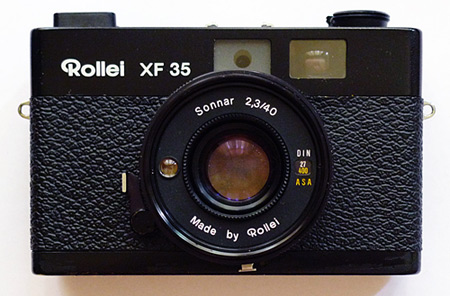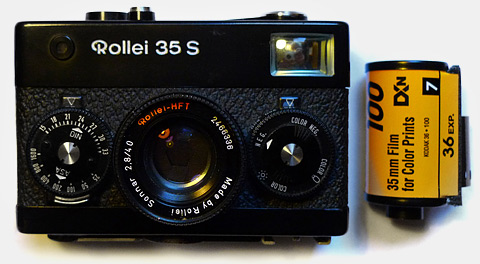Choosing a camera is the first problem that a beginner amateur photographer faces. Each camera system has both advantages and disadvantages that make it more or less suitable for various kinds shooting. Therefore, in order to make the right choice, you need to have a good idea of \u200b\u200bwhat exactly you are going to shoot with this camera.
Almost all existing camera systems are available in both digital and film models, so your choice of camera will not be affected by your preference for one or another technology.
More accessible to the beginner photographer are the so-called small-format cameras (with a frame size of 36 x 24mm or smaller), most of which can now be divided into the following classes:
- compact, or "soap dishes";
- compact cameras for creativity;
- mirror;
- rangefinders.
Compacts, or "soap dishes"
Such a camera is aimed at people who want to think less about the technical aspects of photography. Almost all settings are hidden in the menu, and the camera is highly automated and has a large set of shooting modes for the most common subjects: portrait, macro, night shot, sports, etc. Some models of "soap dishes" are automated so much that they leave almost no opportunity for the photographer to change shooting options.
The quality of photos taken with a "soap box" and the ease of setting are not high, but the cost is also low.
Small size, weight and advanced automation make these cameras the most suitable as an everyday documenting tool that you can always carry with you and take a quick picture on occasion.

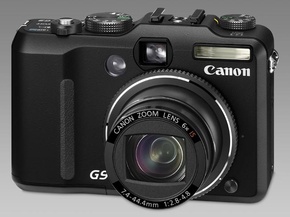
"Creative"
There is a separate class of compact cameras, called prosumer in English, from the abbreviation professional consumer - professional amateur cameras. Simply put, they are intended for those who are not satisfied with fully automatic "soap dishes" and who need easier access to settings and higher specifications cameras. These cameras are geared towards creative use. Often they are even used as professional tool where there are no high demands on the quality of the photo.
For "creative" compacts, the main settings are placed on separate controls and are available directly, not through the menu. There are more settings themselves, and the camera allows you to shoot both in automatic and in full manual mode. The camera has a better quality lens than the "soap dishes" and a more powerful flash.
Often such cameras allow you to install an additional flash, use remote control, have a rotary display and are able to record an image in RAW format. With the help of an optional flash, you can achieve high-quality results when there is a lack of available light. The remote control and swivel display enhance the convenience of shooting self-portraits, close-ups, and other scenes that require the camera to be mounted on a tripod. An image recorded in RAW format, unlike an image in JPEG format, allows strong changes in a graphics editor without significant loss of quality.
The impossibility of changing the lens of a camera of this class is compensated by the ability to install attachments on the lens: tele attachments increase the focal length, wide-angle ones reduce it. In addition, filters can be used.
SLR cameras
They are called so because of the viewfinder device. The mirror inside the camera reflects the light into the viewfinder, allowing you to view the image directly formed by the lens. To take a frame, the mirror rotates to reveal the matrix (or film frame). Such a viewfinder device provides complete control over the future picture, unlike soapboxes, where the frame is sighted either on an inertial electronic display or through an inconvenient optical viewfinder.
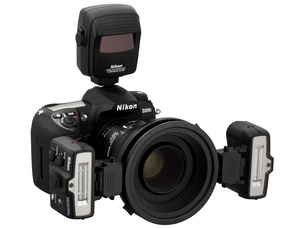

A wide range of interchangeable lenses, teleconverters and macro bellows for them, flashes, battery compartments, viewfinder attachments, interchangeable focusing screens, cable releases (remotes), advanced data transfer capabilities and remote control, numerous settings - all this allows you to solve almost any photographic task.
All settings required during the shooting process are available directly for SLR cameras through separate controls. Thanks to this, the "reflex camera" can shoot dynamic events in the style of a reportage. The automation of these cameras is limited to a reasonable level of non-interference with the photographer's intent. This is inconvenient if you are new to the technical aspects of photography. Therefore, some training is needed to properly use an SLR camera.
The disadvantages of "DSLRs" are the high price of all components, considerable weight and dimensions. You will not put such a camera in your pocket or bag just in case, and it makes sense to buy it only when you clearly imagine that you will shoot with it. These cameras are suitable for experienced amateur and professional photographers.
Rangefinder cameras
Historically, rangefinder cameras are the forerunners of SLRs. Even modern models inherit from previous principles manual control all settings, including focusing, for which the optical rangefinder is used, which determined the name of this class of cameras. The rangefinder has two windows on the front side of the camera, separated by a certain distance, and in the viewfinder, the images from these windows are superimposed on each other. To accurately focus on any object, you need to combine both of its images in the viewfinder. Such a seemingly inconvenient method of focusing the lens nevertheless provides very high focusing accuracy in the most different situations shooting.
Rangefinders, like SLRs, are system cameras. That is, they have the ability to connect various lenses and accessories to them, flashes, cable releases, focusing screens and other system components.
Due to the manual control principle, only an experienced photographer can use the rangefinder camera, who can determine the correct shooting parameters and quickly set the necessary settings. However, there are models of rangefinder cameras that can work in semi-automatic mode: suggest the correct exposure and automatically set the shutter speed.
Rangefinder cameras are quite compact and inconspicuous, their shutter is very quiet. This makes them perfect for street photography. This type of camera is represented in most cases by film models, for which connoisseurs of classic analog photography love them.
In conclusion, it is worth recalling the hackneyed truth: do not forget that no matter how smart photographic equipment is in your hands, it will only be a useless tool if you do not think about your photographs. After all, it is not the camera that shoots, but the photographer.
|
Anton VERSHOVSKY |
|
|
Prologue. You can take pictures with anything, even with a matchbox - everyone knows that. And it's true: there are many good photos taken with a matchbox. But still different types cameras are not easy technical features and solutions, it's a slightly different view of the world. Slow format cameras with interchangeable plates, a little impudent professional SLRs with fast interchangeable lenses, seemingly modest inconspicuous rangefinders - each of these cameras influences the photographer, sets the pace of his actions, determines the style.
A few years ago, it was clear to almost every amateur photographer that “the camera must be digital and reflex”; today this statement ceases to seem an absolute truth. non-mirror digital cameras with large matrices, such as the Olympus Pen, Sony NEX, and the new “almost rangefinder” Fuji X100, are beginning to vigorously push digital SLRs in all directions, and film is again increasing the number of its supporters: experienced photographers who have become disillusioned with digital are returning to it, and newcomers come along, drawn either by the resurgence of film lomography or simply by the charm of film photography.
The most ardent supporters of digital progress already have to admit that film in the new digital world has a place under the sun, which it is not going to give to anyone; therefore, I sincerely hope that now, in 2011, no one will be surprised by a review dedicated to film cameras. Or rather, the most radical alternative to digital SLRs - rangefinder film cameras.
This text has grown from a small to the article "". It, like all the previous ones, is addressed mainly to "street" photographers - lovers of street and genre photography. However, I would not like to reduce my task to a review of rangefinder cameras and lenses; enough such reviews have been written without me. Basically, I would like to talk about those features of rangefinder technology that have made it the number one tool in street photography for eighty years now, and how a street photographer can apply these features.
The drawings and photographs in this article are mine, unless otherwise stated in the caption. I have never seen some of the cameras mentioned below except through the glass of a shop window - for example, Leica MP; but still most of it at different times I tried it in action, and even took it apart. Some of them I later managed to collect.
Dictionary:
. SLR (reflex camera)- a camera that allows the photographer to see in the viewfinder the image formed on the focusing screen by the lens, and directed into the viewfinder by a mirror and prism. At the moment of shooting, the mirror rises, opening the way for light rays to the shutter, behind which the film or matrix is located.
. Rangefinder (rangefinder camera)- a camera equipped with a viewfinder and rangefinder optical systems separate from the lens, using the parallax effect. As a rule, the viewfinder and rangefinder systems are combined, which allows you to simultaneously crop and focus. The rangefinder system is usually mechanically linked to a focusing ring located on the lens.
. Parallax- the phenomenon of changing the angle at which the object is seen, when the position of the observer changes. It is used in optical rangefinders, in which the measurement of the distance to an object is carried out by superimposing images obtained from two different points of view, and then measuring the difference in angular directions. Parallax is also a cause of optical viewfinder errors.
. TTL (Through The Lens)- a method of measuring the properties of an object, such as its illumination, through the lens of a camera.
Advantages of rangefinders. So, what is the attraction of rangefinder cameras?
Firstly, these are cameras with an “aura”: they were the ones who shot almost all the street and reportage masterpieces of the “golden age” of photography, and inscribed the brightest pages in its history; the great photographers of the 20th century are hard to imagine otherwise than with a Leica in their hands. Since 1932, when I bought my first Lake in Marseille, the age of rangefinder cameras in reportage photography began - and the words "rangefinder" and "watering can" were then synonymous. “With a watering can and with a notepad, or even with a machine gun, we went through fire and cold ...” This is Konstantin Simonov, “The Song of War Correspondents”. But then they just didn’t come up with DSLRs with a jumping mirror? And when they came up with it, then all the correspondents immediately got Nikons and Pentaxes, didn’t they?
Correspondents - yes, they got it. But the most rangefinders ... the far-sighted of them did not part with the Lakes; and there is nothing to say about street photographers, they practically ignored the appearance of DSLRs. Look, for example, at the BBC film “Genius of photography” - there, in between retro scenes, a wonderful street photographer Joel Meyerowitz periodically appears in the frame, holding a film Leica MP in his hands. Oh what a camera! It's a pity, five or six thousand dollars. for the carcass and the same amount for the lens, not many can afford ... but the light on it still did not converge like a wedge, there are options that are not so deadly, even with the same Lake.
|
|
Secondly, rangefinders (and other cameras with a separate viewfinder window - we will keep them in mind) are much more compact and lighter than DSLRs. They do not have a bulky compartment with a bouncing mirror, nor a heavy pentaprism. And not only they themselves are lighter, but also the lenses for them - they have no restrictions on the working length of the lens, that is, the distance between the rear lens and the film surface, which in DSLRs is determined by the size of the mirror compartment. This allows designers to manage with significantly smaller dimensions; By the way, for the same reason, lenses for rangefinders, all other things being equal, turn out to be cheaper than lenses for SLR cameras - unless, of course, we are talking about Leica optics.
Here someone can say - is it really necessary to be compact, is it a big trouble to carry two kilograms instead of five hundred grams? But in fact, this is the very case when size matters. And if a wedding photographer or a studio photographer needs a hefty DSLR with an L-series lens in order to impress the customer (otherwise who would believe that he has a cool photographer in front of him?), Then a street photographer, as a rule, needs to attract as much as possible less attention, and most importantly - in no case be like a professional.
The principle here is simple: the larger the lens, the more people are frightened of it - and when frightened, they close themselves from it. Of course, shooting with a compact camera is also no guarantee that you won't get punched in the nose for your impudence; and what's more, it's not the only way disguise. On various photo resources you can find tips on shooting with a camera hidden in a special bag, a camera hanging on the stomach and controlled by a special cable, and even a camera shooting from around the corner - with a mirror built into a fake lens hood. But of course, all these methods are not suitable for a real Jedi. Shooting from the hip is still all right, but by no means a hidden camera. Moreover, if you get caught with a hidden camera, you risk getting into very serious trouble.
There are more elegant ways to go unnoticed. So, the photographer and teacher M. Geller said at one of the forums that his favorite way is to take pictures with a large SLR so that everyone takes you for a harmless tourist. The advice is really good, and not good only in those areas and situations where there is nothing for a tourist to do - namely, they are usually of interest to a street photographer.
In general, recipes that work great in some countries, places, situations, etc. may not work in others. One of the greats, it seems - G. Vinogrand, told his students - smile! They photographed a person on the street - smile at him, and everything is okay. In our country, this number would not have passed, because our citizens are sure that there is nothing more suspicious than a smiling stranger. Therefore, the muzzle is a brick and the expression on this brick, saying "I have full right do what I do” will work much more effectively than a smile. But we digress, let's get back to our rangefinders.
And if we are already talking about invisibility, then let's remember the click of the camera when shooting. For rangefinders, it can be an order of magnitude quieter simply because they do not have a bouncing and clapping mirror, and the volume of the sound depends on the design of the shutter - the central shutters work almost silently, shutters with fabric curtains are a little louder.
Shutters with metal shutters (such as those found in modern Bessa-R rangefinders, for example) can be quite loud; but Bessa cameras are not particularly compact cameras, and the volume of their shutters is compensated by their speed and accuracy.
But you most likely won’t hear the sound of a Rollei 35S, Olympus XA or Olympus 35RC camera on the street - these cameras have non-replaceable lenses, and they are equipped with central shutters. Very characteristic - quiet, but solid - the sound of Leica cameras with fabric shutters.
The next parameter, in which rangefinders, other things being equal, are at least slightly superior to SLR cameras, is the reaction speed when shooting. They do not need time either to raise (and after shooting - to lower) the mirror, or to cover the "jumping" aperture. And focusing on the rangefinder spot takes less time and is carried out more accurately than on the frosted glass of a DSLR, and generates many times fewer errors than focusing using autofocus systems.
And a very important point, especially when shooting at dusk - rangefinders completely lack “recoil” due to the mirror jump, which in DSLRs leads to image blur at medium and long shutter speeds.
And when shooting handheld at slow shutter speeds, another significant difference is revealed: the image in the viewfinders of rangefinders is not blocked by a mirror at the time of shooting. This allows you to confidently shoot even at night, including with “wiring”, which with a DSLR is possible only blindly, on pure intuition.
And, finally, one more, already fundamental difference between rangefinders - fundamental because it literally determines the photographer's view of the world: in the rangefinder's viewfinder, the photographer sees more than he catches in the frame.
The fact is that in a good rangefinder, the viewfinder field of view is somewhat wider than the frame frame, which allows you to see not only what is in the frame, but also what may appear in it in the next second. But for DSLRs, the opposite is true: the viewfinder field of view is always somewhat narrower than the real frame, so the photographer does not see the very edges of the frame, which subsequently often prompts him to crop the photo when printing.
Add to this that due to the lack of a focusing glass, rangefinder viewfinders are always brighter than SLR viewfinders - and in the list of advantages of rangefinder cameras it will be possible to put a dot (.), and move on to discussing their shortcomings.
Disadvantages of rangefinders In fact, compared to DSLRs, rangefinders have exactly one drawback: the photographer sees in the viewfinder not the image that is formed by the lens, but the one that creates the viewfinder lens. This sad fact, which is very significant for still life, portraiture, and close-up photography in general, and not so critical in other genres, manifests itself as follows:
Firstly, in the viewfinder of a rangefinder, everything looks sharp, starting with a few centimeters, and in the viewfinder of a DSLR, what the lens is focused on when the aperture is fully open. But you can put up with this - all the same, the picture either there or there, as a rule, does not correspond to the final result.
Secondly, the effect of the use of filters is not visible in the viewfinder; moreover, the picture in the viewfinder will not change even if you forget to extend the retractable lens or remove the cover from it. Therefore, cameras with TTL metering, or at least with a photo sensor on the front end of the lens, are preferable - they allow you to automatically take into account the influence of the filter on exposure, and warn you about an unremoved cover. A rangefinder is difficult to use with monocles and other lenses designed to beautifully transform reality; the purpose of a rangefinder is not to gloss over reality, but to accurately display it.
Thirdly, replacing a rangefinder lens with a longer-focus or wide-angle one involves, at a minimum, changing the viewfinder frame. In cameras of the Leica system, the frames change automatically when changing the lens, in Bessa devices there is a frame switch. In addition, most models of these cameras are available in different modifications, which differ primarily in the viewfinder magnification: for use with wide-angle lenses - smaller, with telephoto lenses - more. And when using a lens that is too long or too wide, you have to attach an external viewfinder.
And fourthly, and this is probably the most important thing, the viewfinder and the rangefinder lens see the objects of shooting from different, albeit close, points; because of this, the visible positions of objects are shifted and the frames of the frame are shifted. Both are commonly referred to as the parallax problem (Figure 4a). The closer the object, the stronger the parallax (Fig. 5a).
In the descriptions of many models of rangefinders, you can find the words "viewfinder with automatic parallax compensation"; if you believe them, then you can decide that the parallax problem is solved, hooray, rangefinders have some advantages and not a single serious flaw ...
What this actually means is that the viewfinder frame in these cameras is mechanically connected to a rangefinder, which sets it to a position corresponding to the distance to the subject. Thus, only one part of the problem can be solved, namely, when focusing on a close object, the shift of the frame that the photographer sees in the viewfinder relative to the real frame of the frame is compensated (Fig. 4b). And then it is compensated under the assumption that all objects in the frame are at the same distance as the object on which the rangefinder focused!
In other words, if you photograph a drawing on a flat wall, then the automatically moving frame will correctly show the boundaries of the frame; but if you shoot a portrait against the background of a landscape, then you need to be prepared for the fact that the frame will correctly show the position of the person in the frame, but not the part of the background that will be in the picture (Fig. 5b); Figure 5 assumes that in both cases (a, b) we compose the frame so that we get a symmetrical portrait of a person against the background of two trees. Attention - the scales and angles are distorted in order to somehow fit infinity.
And, of course, no moving frames are able to compensate for parallax in frames in which there are both nearby and distant objects; the picture that you carefully build in the viewfinder will in any case be distorted when shooting, as can be clearly seen in the examples below in Fig. 5.
Of course, with some experience, this distortion can be taken into account "in the mind"; or you can, for example, having built a frame, before releasing the shutter, move the camera with “parallel transfer” so that in the place where the viewfinder window was, there is a lens. The main thing here is not to confuse what to move where. And note: with such a "cunning" method of shooting, the frame without parallax compensation at the framing stage will show the frame borders correctly; hence the frame With parallax compensation - lie. To prevent this from happening, you must first set the rangefinder to infinity, build a frame, and only then aim for sharpness and move the camera.
Difficult, right? And this method is suitable only for static scenes ... Actually, it's okay: there are not so many scenes that require such an accurate frame construction when shooting outdoors. Well, except that “The Bride on the Palm” and “Vasya Supporting the Leaning Tower of Pisa” are inconvenient to shoot with a rangefinder, but this, I'm sure, is only for the better.
Choice options. So - rangefinders have advantages and disadvantages; perhaps, in your eyes, the advantages may outweigh, and you decide to get a rangefinder camera. What are your options?
Classic rangefinders - Leica. Firstly, you can immediately focus on expensive, but obviously good equipment. If you choose a real rangefinder with a minimum of baubles and trinkets, then this, of course, is primarily Leica, a product of the engineering genius of Oscar Barnak (by the way, the word Leica itself stands for Leitz Camera - after the name of the owner and founder of the company), the camera with which the rise of narrow film photography. Not only Soviet ones began their history with copying Leica cameras (see Fig. 11), but also many European, American, and Japanese companies - even Kwanon, the first Canon camera, although formally considered to be a development of Japanese engineers, was actually indistinguishable from Leica II.
Now prices for Leica cameras vary over a very wide range, “simpler” models can be found at auctions for four hundred to six hundred cu, the price of “more expensive” models is not limited by anything from above (hereinafter, speaking about the price, I mean the price of “working” cameras The price of specimens in collectible condition can be an order of magnitude higher than the average price for the same model). Variants of the M series with an M mount are considered “classic” (on the Leica I-III cameras produced before them, lenses were mounted on a 39 mm thread) and with frames that automatically change when changing lenses; TTL metering appears starting with the M5. For models M2-M4, the Leicameter was developed - a flash meter that is inserted into the flash shoe and is paired with a shutter speed wheel (but not with an aperture selection ring!).
The most common mechanical model, which has been produced for almost two decades, is the M6 and the M7 that replaced it (one of the main differences of the latter is the electronic shutter) each exist in several modifications that differ in the increase in viewfinders and sets of frames. Modification with a 0.72x viewfinder allows you to use the entire standard set of lenses 28-35-50-75-90-135 mm; in each of the 0.58x and 0.85x modifications, one extreme focal length falls out of the row. Price M6 - about 2000 USD, M7 - about 3000 USD.
The Leica MP has already been mentioned above (see Fig. 1); by the way, abbreviation MP does not mean at all Member of Parliament and not military police, as one might think, mechanical perfection- Mechanical Perfection. That's it - no more and no less. It is clear that the shutter of the MP is purely mechanical, the battery is needed only for the operation of the exposure meter. Frames and viewfinders are the same as the M6; price - about 5000 USD
I am sure that the latter circumstance will force many to look for alternative options. These may be earlier Lake models - but, as mentioned above, they lack a light meter, and therefore are not suitable for everyone.
A "classic from a classic", a camera considered to be the epitome of excellence, historically the first of the still ongoing "M" line, is the M3 (1954): a fully mechanical camera with a shutter speed range of 1/1000 - 1 s, a 0.91x viewfinder, and frames 50-90-135 mm. In order to expand the poor choice of frames for this camera, Leica some lenses, for example - Summilux-m 35/2, began to be produced with special "glasses" - goggles, adjacent to the viewfinder and rangefinder windows, and correcting their magnification; thus it became possible to use the M3 with wide-angle optics. Price Leica M3 - from a thousand USD Also a lot, especially for a camera without a built-in exposure meter.
Here it makes sense to talk about a model that stands completely apart from Leica cameras - Leica CL, the only attempt by Lake's company to make a "people's" camera. This is not a purebred Lake - in the 70s, according to German drawings, it was made in Japan at the Minolta factories. It is more compact than the "classic" watering cans (the most compact and light among cameras with an M mount - only 365 grams), and it has a built-in exposure meter, the sensor of which is located in front of the shutter curtains and is removed when shooting. The shutter speed dial is very conveniently located under the index finger right hand(Fig.7); looking at the exposure meter needle in the viewfinder (Fig. 3) and turning the wheel, the photographer implements something like a semi-automatic aperture priority mode, in which he himself acts as a drive mechanism. Viewfinder magnification - 0.6, frames 40-50-90 - especially for CL Leica released a Summicron lens with focal length 40 mm. The entire viewfinder field roughly corresponds to a 35mm lens. The effective (i.e., multiplied by the viewfinder magnification factor) rangefinder base in the CL is significantly smaller than that of the "older" watering cans, and is only 19 mm.
Leica CL is a fully mechanical camera, with shutter speeds from 1/2 to 1/1000 s, it only needs a battery to power the exposure meter. The price of Leica CL at auctions is 350-600 USD, there are practically none on the domestic market. Not all M-mount lenses are suitable for it - those in which the structural elements are recessed too deep can damage the photocell; of course, folding (or, more correctly, tube) lenses, as well as lenses with “glasses”, cannot be used with it. The history of the Leica CL is sad: the popularity of this relatively cheap camera in the early 70s turned out to be so high that Leitz attributed the falling sales of the unsuccessful, bulky, and significantly more expensive model M5 to competition from the CL - and made a non-trivial marketing move: closed the release CL just three years after it started.
A small digression: since I still need exposure metering, but I don’t have money for the M6, and even more so for the M7, and I wouldn’t want to get an overly expensive camera, which then I would have to protect in every possible way from dangers, and therefore not take it with me on street, - I chose the Leica CL model for myself and I was not disappointed for a minute. "Real" photographers recommend the CL as a "second" camera, but I'm quite happy with it as a "first". Of course, Leica CL, due to its diminutiveness, cheapness, and “mixed” origin, turned out to be somewhat more capricious than its purely German sisters, and more prone to breakdowns - in general, care is needed in handling it. In general, when buying a camera with thirty or forty years of mileage, you need to be aware that it may require wellness procedures - namely, what is called CLA (clean, lubricate, and adjust - cleaning, lubrication, alignment). CLA cameras Leica CL are made by several companies in the USA and England (I'm not sure about Germany), the price of the procedure is about two hundred USD. And if you bought a camera at an auction, it's better to immediately mentally add this money, plus the cost of shipping to repairmen and back, to its price. However, minor repairs that do not require a thorough disassembly can be done at home: here I told you how to disassemble (and assemble back!) Leica CL.
Leica-compatible rangefinders. The popular “folks” Leica CL line was continued by Minolta, which released under the name Minolta CLE its slightly enlarged (it weighs 380g) version with more correct exposure metering, extended to 29 mm effective rangefinder base, and automatic mode aperture priority. If this camera at auctions is not much more expensive than the Leica CL, then this, obviously, should be attributed solely to the absence of the Leitz logo on it. Although, perhaps, the replacement of a mechanical shutter with an electronic one also played a role here.
Leica's main competitors throughout its existence have been Zeiss Ikon cameras, currently produced jointly with Cosina. In terms of their characteristics and price, they are comparable to Leica devices; The debate about which is better has not stopped for many years. They are compatible with Leica M lenses; and besides them, cameras with an M mount are produced by the same Cosina, but already under the Voigtlander brand (Bessa devices), and Konica (Konica Hexar RF).
Bessa cameras are a very interesting option for the photographer who decides to go with the M mount and who doesn't have the option to start with a Leica. The Bessa-R models, marked with the letter "A", are equipped with an electronic shutter with shutter speeds from 1/2000 to 8s, and they have aperture-priority mode; models with the letter "M" - a mechanical shutter with shutter speeds from 1/2000 to 1s. Models 2A/2M have a 0.7x viewfinder and a set of frames 35-50-75-90mm, models 3A/3M have a 1.0x viewfinder and a set of frames 40-50-75-90mm. Models 4A / 4M are designed for wide-angle optics: viewfinder 0.52x, frames 21-25-28-35-50 mm. Otherwise, these cameras are identical; they have TTL metering (their photosensors measure the light scattered by the front surface of the shutter curtains - for this the curtains are painted 18 percent gray), and a full indication of the shooting mode in the viewfinder.
Price new camera Bessa-R with factory warranty is about $800; and in general, Bessa is a unique opportunity to purchase a modern Leica-compatible camera equipped with all modern service functions, paying less than a thousand USD for it. The disadvantages of Bessa include its dimensions - it is a bit large for a rangefinder - and loud noise shutter; in addition, it is widely believed that Bessa cameras are much more prone to breakdowns and endure extreme operating conditions worse than Zeiss and Lakes. And I once had to part with Bessa 3A because of the design of its 1.0x viewfinder: I could see the entire field of the frame only if I literally put my eye into the eyepiece - a trick that I could not do with glasses.
Konica Hexar RF is a slightly more expensive option: from $800. and higher at auctions (it was discontinued in 2003, so it is unlikely that you will be able to buy a new Konika). A very beautiful camera with a minimalistic design, the style of which, perhaps, the LCD display on the upper end of the case falls out a little. The shutter is electronic, the shutter speed range is from 1/4000 to 16 seconds, the shooting modes are manual and automatic (aperture priority), the viewfinder magnification is 0.6x, the set of frames is the same as in the M6 and M7. Without batteries, the camera is absolutely incapacitated - unlike, for example, the M7 electronic camera, in which shutter speeds of 1/60 and 1/125 work even if the battery fails. The viewfinder and frames are bright, although they are inferior in brightness to the M6 and Bessa-R. Film advance is automatic, much louder than in manual cameras; this is to some extent paid off by the convenience of charging and rewinding the film. All in all, a very attractive M-compatible rangefinder, especially considering that it is still half the price of the Leica M6.
Leica optics and compatible. As for the optics, in terms of the beauty of the picture, hardly anything can compare with Leica lenses ... and, unfortunately, in terms of price, too. By the way, Leika also has zoom lenses that allow discrete switching of the focal length, but their price is such that this information is of purely theoretical interest. The cost of fixed lenses of the “inexpensive” Summicron series, depending on the model and condition, can vary from five hundred to one and a half to two thousand USD; Summilux lenses are even more expensive.
A compromise might be third-party M-mount lenses; So, according to Steve Huff, Nokton lenses, manufactured by Cosina under the Voigtlander trademark, are practically not inferior in quality to the legendary Summilux lenses, despite the fact that their price can be an order of magnitude lower (five hundred USD instead of four to five thousand).
By the way, our Soviet lenses "Industar" and "Jupiter" with M39 thread are compatible with the first Leika models, and are installed on later bayonet models through an adapter. And for starters, they are very good - for example, the tube compact Industar-22 (developed on the basis of the Leitz Elmar 50 / 3.5) or the aperture Jupiter-3 (aka Carl Zeiss Sonnar 50 / 1.5). The price of the first one is less than 10 USD, the second one is about 30 USD. When buying Soviet post-war lenses, pay attention to the year of their release: until 1954 inclusive, they were made from trophy glass taken out from Germany under reparations. Since 1954, the domestic industry had to switch to our glass, for which it was necessary to recalculate the circuits of most lenses. Which option turned out better - guess for yourself.
Compact rangefinders. And if you need compactness, and besides, you don’t want to pay more than one and a half hundred dollars for a camera, then good choice there will be non-interchangeable rangefinders such as the Canonet QL17, Olympus 35RC and 35RD. The Olympus XA camera stands apart from the Olympus series - this crumb, which looks like a real plastic soap dish (the one in which soap is kept), is actually a completely full-fledged rangefinder with aperture priority mode, a shutter speed range of 1/500 - 10s , and a very sharp Zuiko 35/2.8 lens; By the way, this lens is also unique in that the distance from the front surface of its front lens to the film is less than the focal length - which SLR can boast of this?
|
|
In general, cheap cameras should be treated with caution - very often the desire to reduce the price forced camera manufacturers to use design solutions that sharply worsen their parameters - for example, the design of the diaphragm was simplified, and it became rhombic from round; the rangefinder base was reduced to one to one and a half centimeters, shutter speeds shorter than 1 / 500s and longer than 1 / 30s were thrown out, it was impossible to independently change the aperture and shutter speed, and in general somehow control the process of setting exposure parameters, etc.
Fig. 10 shows an interesting Rollei XF35 camera, which combines quite good quality of the Sonnar 40/2.3 lens and noble simplicity of form with all the shortcomings listed above; very similar models were produced by Voigtlander, Canon, and others. From these cameras there was only one step left to the infamous "soap dishes" that flooded store shelves in the 90s.
|
|
They say that the Yashica Electro 35 is not bad in the same price class, in any case, Ken Rockwell writes that it has everything you need (in particular, the aperture priority mode), and there is nothing superfluous. An important advantage of this camera is its availability (Yashica has sold more than eight million different modifications of the Yashica Electro 35! However, the Guinness book record holder is still not her, but the LOMO plant with its Smena-8 - twenty million copies). The disadvantages of this camera are the lack of manual installation shutter speed, and a hefty weight for a rangefinder - 750 grams. If you are going to buy this camera, pay attention to the modification: cameras released before 1970 cannot work with film with ISO higher than 500.
Soviet rangefinders. The Soviet cameras "Zorkiy" and "FED", which were originally copies of the Leica II, and then subjected to significant modifications, are suitable for those photographers for whom the lack of a built-in exposure meter, movable frames (and any frames in general), long and short shutter speeds are not a significant disadvantage. If you are not a real fan of old cameras, then I do not advise you to take their very first models (Fig. 11), in which the film is loaded from below - their charging can become a serious problem; in addition, in these devices, the viewfinder and rangefinder eyepieces are separated, and the viewfinder window is very small and dim. To some extent, the disadvantages of these cameras are compensated by their compactness, reliability, and unpretentiousness, and most importantly, by their Leica charm, which the following models are completely devoid of (by the way, be careful: most of the “rare” Leica II cameras on the market are nothing but as fakes made from these devices). Of the subsequent models, Zorkiy-4K is probably the closest to the optimum - a rather rare modification with a trigger platoon.
Another line of Soviet rangefinders - "Kievs" - were copies of the Zeiss Contax with the Zeiss Contax RF mount. They differed from Zorki and FEDs by their significantly larger size and weight, the presence of short and long shutter speeds, and a uniquely large rangefinder base - 90 mm with a rangefinder magnification of 0.7x. The 3rd and following models had a built-in selenium exposure meter - unfortunately, selenium degrades over time, and at best these exposure meters now require renormalization. Kyiv-5 is equipped with a trigger cocking and a 50 mm frame with parallax compensation. Standard lens - Jupiter-8 (50/2).
autofocus technology. Fans of expensive autofocus automation can be advised as a result of cooperation between Zeiss and Kyocera - Contax G1 and G2 devices with a line of high-quality Zeiss optics (28, 35, 45, 90 mm), including even a 35-70 mm zoom lens! The automatic version is simpler, without interchangeable optics - this is the Konica Hexar AF. These are not quite rangefinders - they do not have a manual rangefinder with a spot in the viewfinder field, focusing is carried out either automatically or on a scale. These cameras also do the film advance themselves - I don’t know how it is for anyone, but I prefer the classic silent trigger platoon. He clicked - cocked, and no roar of motors, and no batteries needed.
Autofocus cameras with non-replaceable optics Contax T2 and T3 are very nice; the latter competes with the Rollei 35S in terms of compactness (Fig. 12). Its body is made of titanium, it is equipped with a Sonnar 35/2.8 lens, aperture-priority mode, automatic film advance and rewind, built-in flash, etc. In terms of the degree of automation and contours, it is very reminiscent of a "soap dish", differing sharply from it both in quality and in price - about 750 USD.
scale devices. Scale cameras are very good, similar to rangefinders for everything, except for the absence of the rangefinder itself; the need to estimate the distance "by eye" in them is compensated by unsurpassed compactness. Their use in street photography is justified by the fact that it rarely uses shooting at open apertures with background blur, and therefore, as it turns out, it is not so difficult to do without a distance meter. For example, the camera can be pre-focused on the so-called hyperfocal distance, at which the zone of sharpness starts from a few meters and ends in infinity. This technique, which provides maximum efficiency, is often used when shooting with rangefinder cameras.
Of the foreign scale 35 mm cameras, the most interesting is probably the Rollei 35S (the choice of the Queen of England!) with a mechanical shutter with a shutter speed range of 1/500 - 1/2 s, a magnificent Zeiss Sonnar 40 / 2.8 retractable lens, a built-in coupled exposure meter and an ingenious clamping table. The controls on this smallest 35mm camera are placed quite unusually - the shutter speed and aperture wheels are on the sides of the lens, the cocking lever is on the left, and the flash shoe is generally on the bottom! And the film in it is fed from right to left, so you need to insert it into the scanner / enlarger by turning it 180. But you get used to all these features very quickly. I was somewhat unnerved that the exposure meter of the Rollei 35S was on all the time and was using up a scarce battery (less in the dark than in the light, anyway). A solution to this problem is described in my blog, a solution to the problem of replacing old mercury batteries used in the last century in almost all rangefinders and scalers -.
|
|
And we can recommend from our scale cameras - you will probably be surprised - the well-known Smena-8. Of course, this device is far from perfect, but it is extremely cheap (three or four dollars), and at the same time, with some skill, it allows you to get very good pictures. True, its design requires the use of a receiving cassette, which must be replaced periodically, otherwise its curtains begin to scratch the film; and with collapsible cassettes in our time is tight. Again, with some skill, collapsible cassettes can be made from non-collapsible ones, knocking out their bottoms with improvised means.
lomographic cameras. Recently, many so-called lomographic 35 mm cameras have appeared on the camera market - cheap plastic boxes with plastic lenses, one shutter speed, and at best two apertures (usually F / 8 and F / 11). The cocking of the shutter in them is not associated with rewinding the film, which gives a lot of opportunities for creativity (especially unintentional) in the genre of multiple exposure, i.e. shooting several scenes on one frame of film. Some of these devices, for example, the already well-known Diana-mini, are characterized in their own way (in the spirit of modern pictorialism) by a very nice picture - just don’t try to shoot a reportage or glamour!
So, the possibilities before us are countless. I don't think it's worth trying to compose full review rangefinder and scale cameras - the purpose of the article is not this, but to give some guidance to those who are interested. I don’t give links to descriptions of specific cameras simply because it’s no more difficult to find them in Google or Yandex than on this page - the main thing is to know what to look for. And for further reading, I highly recommend the article “Accident or trend? » V. Samarin and A. Sheklein - it not only tells about the advantages of rangefinder cameras, but also discusses in detail the features of the most interesting of them. And, of course, the rangefinder.ru website - you can find any information about rangefinder cameras on it.
A few words about the choice of optics for street photography. In general, of course, lenses with any focal length can be used for street photography, but I would not advise getting too carried away with wide-angle and long-focus lenses. Wide-angle lenses produce frames with accentuated structure and spectacularly distorted space, but this effect - like any effect - quickly becomes boring; in addition, external viewfinders may be required for wide-angle lenses. The reasons why telephoto lenses are not suitable for street photography were perfectly formulated by Petteri Sulonen in the article "Telephoto is for cowards". In general, a “standard”, that is, as close as possible to normal human perception, is considered a lens whose focal length is equal to the diagonal of the frame - that is, 42 mm for a narrow film. Accordingly, if you have not yet developed your own preferences, then for a start it makes sense for you to look at 35-40-50 mm lenses (it is important that your camera has the appropriate frames!) It is difficult to work with lenses of 135 mm and more without special devices on rangefinders , so it makes sense to limit yourself to a focal length of 90 mm from above.
You should also not attach special importance to the aperture ratio of the lens: on the street you will not have many opportunities to realize this aperture ratio. Shooting at an open aperture requires careful focusing, and street scenes are usually dynamic, and besides, they stubbornly refuse to fit in one plane. Therefore, it is quite rare to open the lens aperture more than F / 5.6; therefore, for evening and night shooting, you will have to use long exposures (and we have already said that rangefinders are better suited for shooting at long exposures than any other), and high-speed films. If you develop at home, then you don’t have to spend money on expensive films with high ISO: up to 1600-3200, you can increase the sensitivity of almost any black-and-white film that initially has a sensitivity of 400 units (the so-called push process) during development. Color films can also be "pushed", but not every laboratory does this.
Shooting with a rangefinder. So we got to the main topic of the article. So: we load our rangefinder with a film - this process is infinitely diverse, and in each camera it follows its own laws. The hardest thing to load is the first Watering Cans/Zorkie/FEDs, designed for film with a long tail, the length of the camera; this tail must be carefully cut with scissors, after which the film usually begins to break and split along the cut right in the camera. And the easiest thing is Canonet QL17: you just need to put a cassette in it, pull out the film tail a little and close the lid - then it will do everything by itself. This service is familiar to everyone from “soap dishes” and DSLRs with motors, but in a mechanical device it pleasantly surprises, as well as the presence of a correct charging indicator window. After loading the film, you need to take a couple of trial shots, and at the same time check whether the film rewind lever (it turns out to be linked to the feed cassette) is spinning when the film is advanced to the next frame.
Shiny parts of the camera, as well as all sorts of defiant inscriptions like “Leica”, “Zeiss”, “Rollei” and the like, it makes sense to immediately seal it with black tape. There is a legend that Henri Cartier-Bresson did this, so it’s not shameful for us either. You no longer need any wardrobe trunks and photo bags, you are not some kind of SLR! But still, it makes sense to rummage through the rubble of all sorts of garbage in photo commissions in order to find the most unpresentable case for your camera that looks too pretty; for example, as it turned out, the case from Smena-8 fits almost perfectly with the Leica CL. Just remember to sanitize this case before use, and replace any flimsy mounts on it with new ones. If you have found a suitable case - good, if not - get ready to hide the camera from rain, snow, dust, and policemen under a jacket.
Put a 35-50 mm “street” lens on the camera (for cameras with non-replaceable optics, the focal length most often lies within these limits anyway); set the aperture to the number "8", and the distance to the object - to hyperfocal, that is, approximately 5 meters; do not carry interchangeable lenses with you, it is better to immediately tune in to the one that is installed on the device. If the camera does not have aperture priority mode, figure out what shutter speed you will need - if you do not have an exposure meter, you can first use any digital camera instead: very soon you will learn to do without it, determining the shutter speed “by eye”.
After that, it remains to hang the camera on your shoulder or around your neck - and, as it was said in one excessively poetic book about photography - "with the gait of a primitive hunter in the tundra" go for a walk on the street, and there she herself will tell you what to do .. .
That seems to be all. Thank you for your attention.
Yes, while listing the advantages of rangefinder cameras, I forgot one more thing: they are very beautiful. They are an example of how a technology brought to perfection inevitably finds a perfect, and therefore a beautiful form.
"From Moscow to Brest
There is no such place
Wherever we wander in the dust.
With Leica and a notepad,
And even with a machine gun
Through the fire and the cold we have passed.
These are lines from a good Soviet military song. So what kind of “Lake” is it singing about? Not about the same one from which the flower bed is watered!
In 1914, in Germany, engineer O. Barnak created a small-format camera, which since 1924 began to be produced by the Leitz Company under the Leica brand. This camera was designed for 35 mm film, which was used in motion pictures at that time. The designer decided that these films were fine-grained enough to provide even with a fivefold increase in the frame (i.e., a photo of 13x18 cm) good quality, despite the fact that the standards of that time were prints of 6x9 and 9x12 cm, obtained by contact printing. Barnak has designed a compact, ergonomic, apparently very simple camera. This camera had a fundamentally new focusing device in photographic technology, which is called a rangefinder.
The principle of operation of the rangefinder is explained in the figure below:
The rangefinder has two windows on the front of the device and one eyepiece for viewing. The mirror system creates an overlap of two images in the eye. If the rangefinder is not pointed at the correct distance, then we see a small fragment from the second window that does not match the main image. When the lens focus ring is rotated, the mirror in the rangefinder is simultaneously rotated. The system is adjusted so that when the lens is in focus, both images match. For convenience, in the second window (where there is a small rotating mirror) a light filter is installed, usually yellow, which helps to better distinguish images.
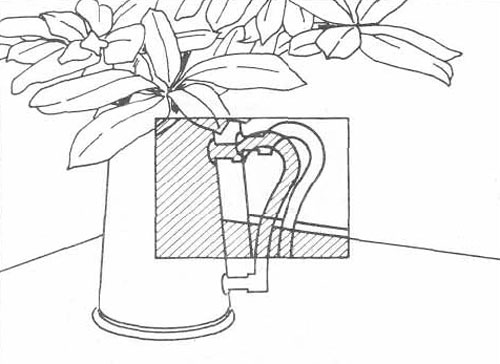
However, on the first Lakes, the rangefinder was installed in the flash socket and was not paired with the lens, i.e. first it was necessary to measure the distance, and then set it on the lens scale. The lens was rigidly mounted to the camera.
The first Lakes looked like this:

And Leika with a rangefinder installed can be seen in the article by G. Abramov "35mm rangefinder cameras: history and renaissance." Chapter "Pre-war period".
The watering can was greeted with skepticism and was initially sold poorly. However, the company did not give up and continued to improve the camera. Pretty soon, in 1930, the first interchangeable lenses with different focal lengths were developed and released. Now the lens is mounted on threaded connection and changing the lens took a matter of minutes. This was also a fairly new practice. A year later, the company standardized lenses - before that, the lens for each camera (not only for Lake) was selected (finished with a file;)) individually, and now any branded lens could be installed on any Lake camera. Photographers shooting in different genres no longer needed to buy several devices - it was enough to buy a Leica and a set of lenses. Of course, a 24x35 mm frame provided a worse resolution (detail level) and a photo enlarger became mandatory for making prints, but this disadvantage was more than offset by the advantages of small dimensions and convenience with high focusing accuracy.
The next model, Leica II, gained popularity. The rangefinder, finally, was built into the design of the device and paired with the lens. It is curious that in 1952 and 1957 Leitz produced Leica models not only without rangefinders, but also without sights. But, instead of one, these Lakes had two sockets for attaching a flash or other “attached” equipment. I did not find exact information, but I assume that the devices were equipped with interchangeable rangefinder sights for different lenses. Or maybe it was a cell for the poor, along with a three-wheeled BMW microcar of the same time?
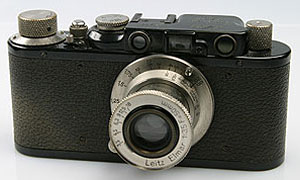
By 1936, a large range of lenses and accessories was being produced for Lake, i.e. from a camera, Lake turned into a Leica system. Leica's success forced Carl Zeiss (Contax cameras), then Agfa (Karat cameras) and Kodak (Retina cameras) to move in the same direction. As a result, cameras using small-format film 35 mm wide became the most popular, and contact printing replaced printing with magnification (the slogan of that time was “small frame - large magnification”). If I'm not mistaken about the dates, Lake became the working tool of the great photographer Henri Cartier-Bresson around this time.
Lake-2 has become a role model and copying in various countries. In particular, copies of Leika under the name "FED" began to be produced in 1934 by the workshops of the Children's Labor Commune of the NKVD of the Ukrainian SSR. F.E. Dzerzhinsky. The device was produced from 1934 to 1955.
FED, like Lake, had a curtain-shutter shutter made of rubberized fabric shutters with shutter speeds: B (manual), 20, 30, 40, 60, 100, 250, 500. The rangefinder and viewfinder had different viewing windows; the viewfinder had a magnification of 0.44x, the rangefinder had a base of 38 mm and a magnification of 1.0. The bottom cover was opened to charge the camera, which was a big inconvenience. On the other hand, this design well protected the mechanisms from dust and dirt during reloading. 3.5/50 lens in a retractable tube with the following aperture steps: 3.5, 4.5, 6.3, 9, 12.5, 18. Threaded lens mount - M39.
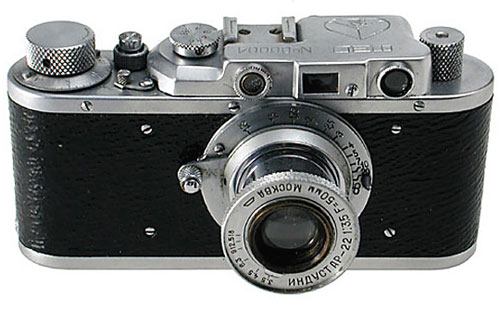
The history of the creation of the FED is briefly described in the article “The Birth of the Soviet Leika”, I. Cherny, Proletarian Photo magazine, 1933.
After the Great Patriotic War, the Krasnogorsk Mechanical Plant (KMZ) began producing Zorki cameras (Zorki-1), 1948-1956. Zorky was identical to the FED, i.e. was also an exact copy of Leica 2. A total of 835,502 "Vigilant" were produced.
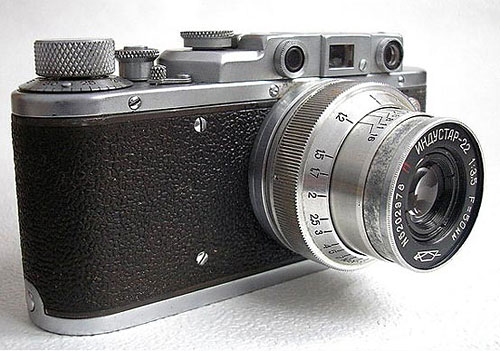
I have a special relationship with the Zorkom - this is the first camera with which I started taking pictures at about 7 years old (with the help of my father, of course).
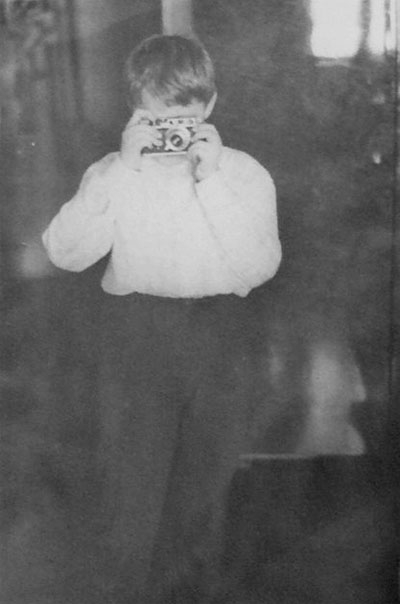
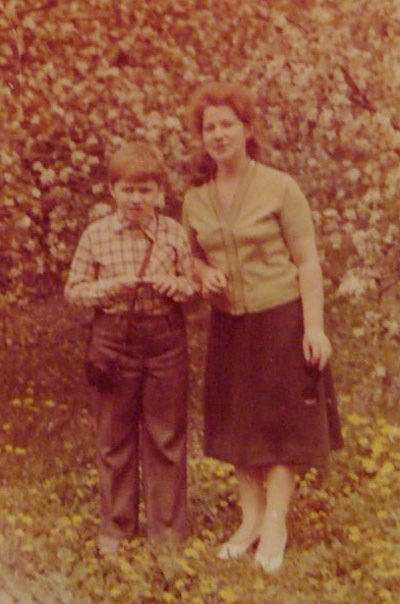
The first photo shows the author himself, armed with a Zorkiy camera, the second photo shows the author and his mother on a photo walk. I apologize for the quality of the photos - many years have passed since then.
I still have this camera in a place of honor on the shelf, it is still fully operational - load the film and shoot (but too lazy to mess with developing and printing: ()! A characteristic feature of the design and appearance Watering cans and their copies - a regular lens was made in the form of a retractable tube, like in modern digital cameras, only manually. Here's what it looks like:
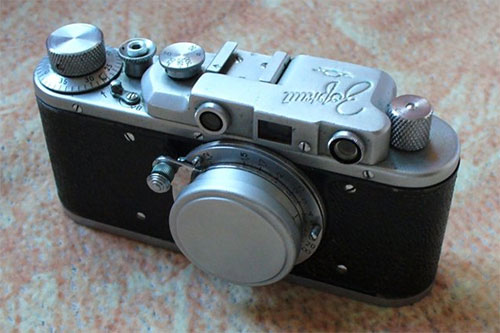
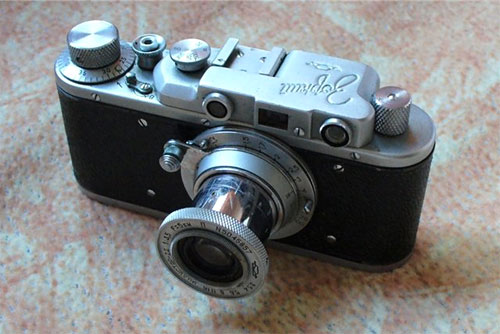
Two round windows on the front panel - range finder, rectangular - viewfinder.
The subsequent models "FED" and "Zorkiy" were also basically analogues of the following Leica models.
The most interesting among them, in my opinion - "Sharp-3"(1951-1956) - an analogue of the Leica III - had higher performance, a viewfinder combined with a rangefinder, "Zorkiy-3C" was finally equipped with a flash sync contact (another one of our family cameras, unfortunately, has not been preserved).
Further models Zorkiy-4, -5 and the last in the Zorkiy-6 line (1959-1966) were gradually improved, while maintaining the characteristic appearance of the classic Leica. The next model was the Zorki-10, 1964 - 1977 - a completely re-styled semi-automatic camera with a built-in exposure meter in the front of the lens. After 1977, the plant completely stopped the production of "Zorkih" and focused on the production of only "Zenith" SLR cameras.
But various FED models continued to be produced, among them FED-5, FED-5s, 1977-1990. The model was equipped with a built-in exposure meter. The automatic "FED-Mikron 2" (1978-1986) was also released, and the last in the line - "FED-35", 1985-1986.
The information is given according to the material of G. Abramov
rangefinder camera
Rangefinder camera FED-3
rangefinder camera- a class of cameras that uses an optical rangefinder for focusing.
To focus the rangefinder camera, rotate the lens distance ring until the split image is aligned in the viewfinder window. Early models of rangefinder cameras had separate viewfinder and rangefinder eyepieces; then the rangefinder was combined with the viewfinder. Then the rangefinders were connected to the focusing mechanism of the camera, so that focusing was carried out simultaneously with the combination of images in the rangefinder.
Story
The first rangefinders, sometimes called "telemeters" ("telemeters"), appeared in the 19th century. The first rangefinder camera was the No. 3A Kodak Autographic Special made in 1917.
Not being a rangefinder camera, the Leica I, released in 1925, made the rangefinder common as an optional accessory. Issued in 1932
Rangefinder cameras have dominated photographic technology since the 1930s, beginning to give way to SLR cameras from the 1960s.
Rangefinder cameras were produced for all formats of photographic materials: small-format, medium-format, up to large-format reportage cameras. Film cameras with folding bellows, such as the Balda Super Baldax or Mess Baldix, Kodak Retina II, IIa, IIc, IIIc, and IIIC, and the Hans Porst Hapo 66e (a cheaper version of the Balda Mess Baldix), were often fitted with rangefinders. Among the small format cameras built-in rangefinders were the M39 cameras), designed by Oskar Barnak for the optics manufacturer Ernst Leitz Wetzlar (and giving rise to many imitations), the Contax cameras produced for Carl Zeiss Optics by his Zeiss-Ikon division (and after the defeat of Germany in World War II produced in Ukraine under the brand name "Kiev"), Nikon cameras series "S" in 1951-62. (whose design was emulated by Contax and construction by Leica) and the Leica "M" series cameras.
Nikon rangefinder cameras were "discovered" for American consumers in 1950 by Life magazine photographer David Douglas Duncan, who was covering the Korean War. . Canon produced several models from the 1930s through the 1960s; models from 1946 more or less compatible with threaded connection
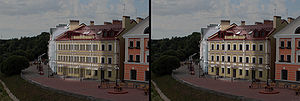
Part of the image in the viewfinder of a rangefinder camera. Left - unfocused image, right - focused.
- Less camera shake when shooting due to the lack of a mirror lift mechanism - less chance of shake.
- Less shutter noise.
- The time from pressing the shutter to opening the shutter is shorter, since there is no time spent on raising the mirror - more opportunities for shooting fast-moving events.
- The viewfinder remains open at the time of the picture - it is possible to detect defects and immediately reshoot, especially when shooting with flash.
- In some rangefinder cameras (like Lake), the viewfinder field of view is wider than that of the lens, which contributes to more accurate and convenient framing.
- The lens can occupy the entire space of the camera before the shutter - more freedom in lens design, the ability to create better and faster lenses at the same price.
- The compactness of the camera, the possibility of using a folding lens.
Disadvantages of rangefinder cameras
- It is difficult to work with long lenses, as there is not enough rangefinder accuracy. It was overcome with the help of attachments, like a SLR camera, placed between the lens and the D.F.
- Macro photography is difficult due to parallax and shallow depth of field. With a stationary installation - it is overcome by preliminary aiming on frosted glass, for operational work- irresistible. It is facilitated if the camera has automatic parallax compensation.
- In the absence of a TTL exposure meter, it is possible typical mistake- shooting with the lens cap closed.
- For interchangeable lenses significantly different from the standard (usually 50mm), interchangeable viewfinders are required.
- With classic mechanical DFs, it has only recently become possible to use zoom lenses. On modern electronic cameras, this problem has already been solved.
The first optical rangefinders were equipped with cameras Leica. In the very first models, it was just a convenient and effective additional device. With the improvement of the camera, the role of this element also increased; ten years later, the optical rangefinder has already become an integral part of the camera. But also certain time sharpening was carried out in several stages.
In 1932, manufacturers of photographic equipment of the Leica brand produce completely new model - Leica II. This camera already had a valuable advantage - a rangefinder was included in its design. The same device was installed in the camera Contax I, which was only the first model of Contax. Leica specialists had a richer experience in the production of photographic equipment, their products had significant advantages. But the Contax I camera also made it possible to take high-quality pictures, was used for professional shooting, was equipped with such elements as a bayonet for mounting optics, an effective rangefinder base. The subsequent model already demonstrated the integration of the rangefinder and viewfinder into a single unit. The design of the photographic equipment of this company was also interesting - it was distinguished by style and respectability. Such a rangefinder camera looks like a real professional photographic equipment.
Both lines of cameras, Contax and Leica, have been constantly improved. By the 1940s, rangefinder cameras made up the majority of such equipment. Despite the release of rangefinder cameras by American manufacturers, it was German photographic equipment with optical rangefinders that for a long time was the most famous and in demand even in the 60s.
External signs and the mechanism of operation of the rangefinder
The design of the rangefinder consists of a pair of lenses that are located at a certain distance, as well as an eyepiece and a deflecting system. The distance between the lenses is called the rangefinder base. One of the lenses, the main one, is in a straight line with the eyepiece. To direct the light flux between the objective lens and the eyepiece lens, a translucent mirror is installed. The light flux is directed from the additional lens to the eyepiece of the viewfinder. The design of the rangefinder also uses a movable deflecting mirror, it serves to transmit the light flux from the additional lens to a translucent mirror. The movable mirror is connected to the main lens, or rather, to its focusing frame. When the focusing frame is rotated, the movable mirror shifts, so the image on the translucent mirror of the optical rangefinder also shifts. The correct focus of the lens occurs when the images from both lenses merge on the subject that is selected for shooting.
Binacular vision of a person, that is, two eyes, is the basis for the construction of a rangefinder. This simple device allows you to determine the distance to the subject of photography. In most cameras equipped with a rangefinder, the lens automatically focuses. Also, this device allows you to focus using the distance scale.
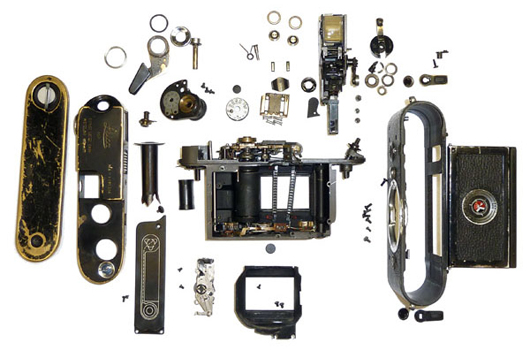
Differences from SLR cameras
Compared to SLRs, rangefinder cameras allow you to take better pictures. Collision of lenses with a moving mirror is excluded. Both the lens of rangefinder cameras and they themselves are small in size and weight. Due to the lack of a movable mirror, the camera does not vibrate in the hands of the photographer, so you can not use a tripod to shoot with such equipment. Cameras with optical rangefinders are much quieter.
There is a large selection of different lenses, including wide-angle, ultra-wide, which effectively affect the quality of photography. Unlike a reflex camera, rangefinder photography equipment allows you to always see the shooting scene, the viewfinder does not periodically turn black.
But there are some disadvantages of rangefinder cameras. For example, on a mirror, you can immediately see the image that will fall into the picture. In another type of equipment, the viewfinder is separated from the lens. There are some limitations in terms of lens selection - for example, it is difficult to choose a model with special effects. SLR cameras can be used when shooting at any distance, but those equipped with an optical rangefinder are not suitable for photographing closer than 60-100 cm.
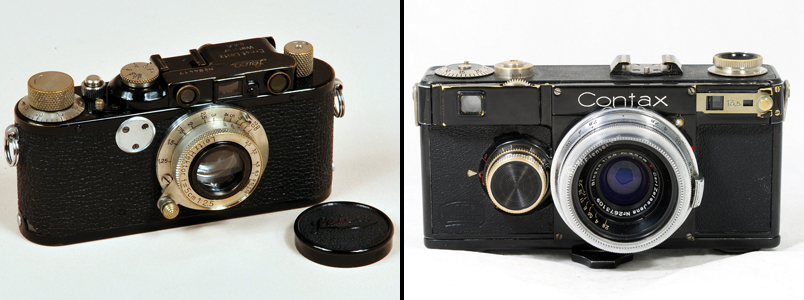
The process of shooting with a rangefinder camera
When photographing with a rangefinder camera, you need to take into account that the subject will be a little further than it seems in the photo. This technique is very convenient to use for photo reporting on the street - small equipment will not attract attention. Such cameras are chosen for professional sessions by journalists, especially in pursuit of sensations. The equipment is quite simple to use, some processes that include the shooting technique, for example, setting the shutter speed, focusing, setting the aperture, are performed manually. For many professionals, this principle (control of the camera) is more convenient. Rangefinder cameras are suitable for those who do not rely on additional effects, but like to pay attention to the subject, creating an expressive image and composition in the frame. .
Show html code to embed in blog
The principle of operation of rangefinder cameras
The first optical rangefinders were equipped with Leica cameras. In the very first models, the rangefinder was just a convenient and effective additional device. With the improvement of the camera, the role of this element also increased; ten years later, the optical

